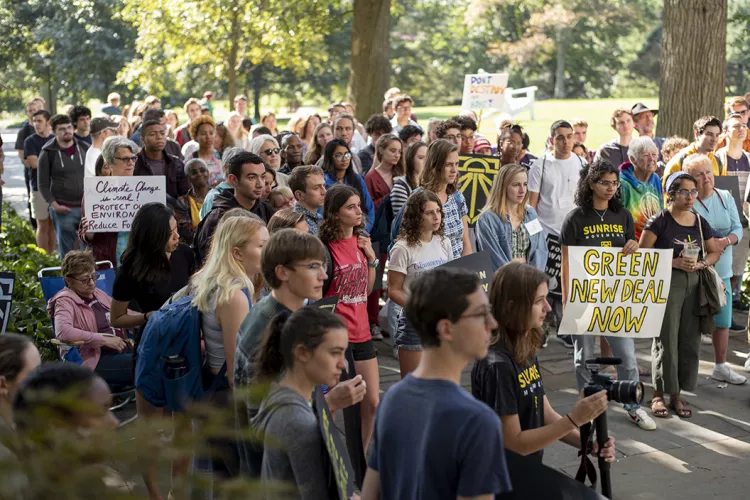Confronting the Climate Crisis

More than 100 students and other community members rally in front of Parrish Hall for the Global Climate Strike.
Millions of people from more than 150 countries around the world are taking action against the climate crisis by participating in today’s Global Climate Strike, timed to occur three days before the United Nations Climate Action Summit in New York. Members of the Swarthmore community are among them. Following a mid-day strike in downtown Philadelphia, some faculty and students plan to lead on-campus discussions centered on the climate crisis.
In a piece he recently co-authored for The Guardian, Professor of Sociology and Peace & Conflict Studies Lee Smithey says that educators “risk losing credibility with an entire generation of students” if they do not support students in their efforts to address the climate crisis. “It’s true that school time is precious, and to teach is a revered responsibility … To strike in the name of climate justice is a resounding endorsement of learning,” Smithey wrote. He and environmental studies professor Giovanna Di Chiro wrote an open letter with colleagues from around the country urging others to join the effort.
“Let us find ways,” they wrote, “to focus our collective determination on the global threat that defines this time.”
Swarthmore has a deep and longstanding commitment to sustainability, built on a Quaker legacy of shared responsibility, social justice, and careful stewardship of resources. President Valerie Smith underscored that commitment today by signing the Sustainable Development Goal’s Climate Emergency Letter, adding Swarthmore College to the growing list of more than 160 higher and further education institutions around the world that have collectively declared a global climate emergency.
“The climate crisis poses an unprecedented challenge to our global society — a challenge that we must meet with urgency and action. Institutions of higher learning are uniquely positioned to facilitate informed discussions of this crisis and ways it can be addressed,” Smith said, echoing the call for action she made when she approved the College’s award-winning carbon charge program. “We have a responsibility to adapt our own institutional behaviors and processes.”
In addition to the carbon charge program, the College’s commitment to carbon neutrality by 2035 and the President’s Sustainability Research Fellowship (PSRF) Program are initiatives that have made Swarthmore a leader in raising awareness and reducing the College’s impact on the environment.
Achieving carbon neutrality by 2035 will require eliminating the College’s greenhouse gas emissions from electricity, natural gas, transportation, construction, and procurement. The Roadmap to Zero, the College’s energy master plan for achieving this goal, is in development.
Through the PSRF program, students learn by leading as they assume stewardship over vital sustainability challenges. The program matches motivated students with small teams of staff and faculty mentors to research, develop, and implement projects in a yearlong course and associated internship. Recently, PSRFs have helped redesign the campus waste management system, developed a three-year plan for stewardship of the Crum Woods, and launched behavioral change strategies to reduce greenhouse gas emissions, among other projects.
Swarthmore faculty have also worked to ensure the College’s curriculum addresses the climate crisis. Perhaps the latest tangible example is the creation of a Global Studies Program, which strengthens Swarthmore's efforts to shape engaged citizens not just with a local or a national conscience, but also with a global one. The new program also complements the College’s well-established and robust Environmental Studies Program.
“There should be no question that the climate crisis poses an extraordinary threat to human well-being around the globe,” says Provost Sarah Willie-LeBreton. “Swarthmore’s singular liberal arts education enables educational experiences in which students and faculty engage in learning and discovery both inside the classroom and out in the world.”



